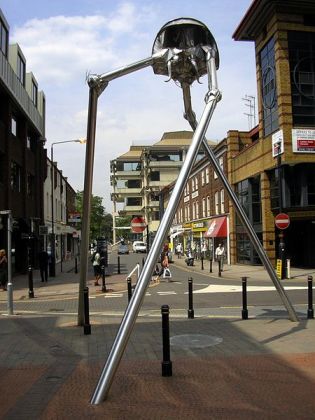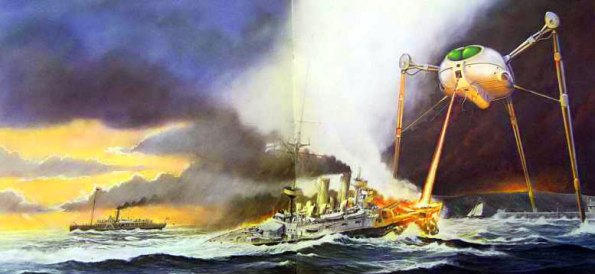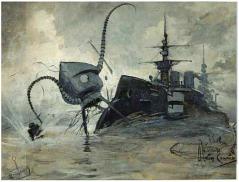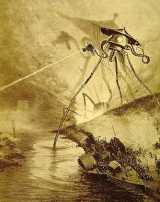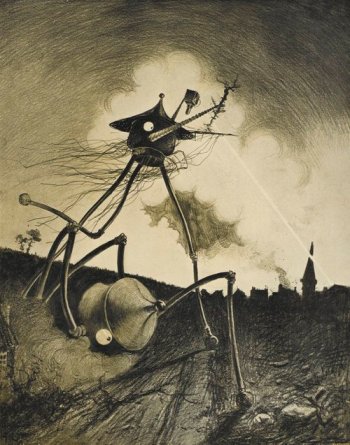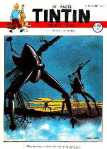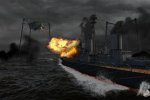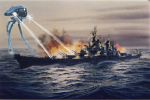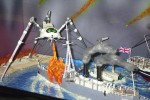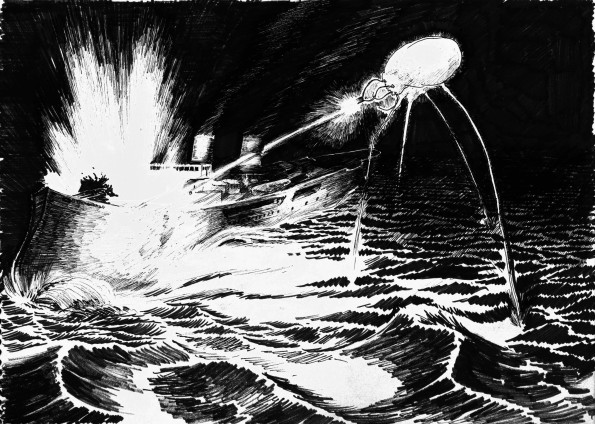Archive
In praise of original Battletech and parsimonious rewards
I’m too busy to be blogging and I have a self-imposed rule not to just wax nostalgic here, but Gordon Cooper directed me to Jeff Rients’s recent post on first-version Battletech and…
See, the arrival of the clans was the first time I realised that power creep and complexity could spoil my fun.
I got clued into Battletech about a year before the return of the clans was released and before FASA’s canon story cranked into gear (which powered a series of further releases in several different media and made me all excited about the possibilities for being a writer/designer of an entire game line, like the Tolkien of a new creative world explored originally through play etc etc.). So I just about had time to get confident with the game before it changed forever.
And immediately I could see that the change was a double-edged sword.
On one hand, it was wildly exciting – all the new stuff to geek out about, the potential for a massive player league actually writing history in real-time on tables around the world, which would be published and would update everyone’s game. This was before the internet: the idea that your game could affect someone else’s a continent away? Wild.
On the other hand, Battletech worked. And it taught me a bunch of lessons that are now OSR mainstays. It was a nice little game you could teach and play in a day – complex but not unmanageable. And it was pleasingly incomplete, which meant you could make it work your way. It encouraged tinkering and the setting encouraged the same kind of tinkering, so you could kinda roleplay as you tinkered. That’s a feature I’ve long dreamed to getting into a game design, BTW. And I’ve never managed it as elegantly as Battletech.
For instance: the original low-cost Locust was, like many pieces of Vietnam-era military design, clearly conceived for a very specific mission and partly crippled for any wider application. “What use is such a tiny mech?” you could hear Kerensky scoffing. “Perhaps against infantry. Give it machine guns and send it to quiet street riots and it won’t be a total waste.” No. The rules allowed you to take out the MGs and give it 3 medium lasers. Suddenly its high speed plus reasonable punch made it an effective weapon and my favourite toy.
And the whole system was delightfully balanced, elegant and well-considered. Its parts fit together seamlessly. You could design your own mechs and they would delightfully be just a bit more effective than the ones in the original book but there was no killer combo that rendered all others obsolete. Heat, damage, movement, armour, cooked together just right for maximum tactical pleasure. And the people I played with got that, too, and it encouraged a certain refinement in their design sense. I got kudos for realizing the potential of the Locust within the design system. When I suggested it could be made even better with the addition of a new element – a sticky mine, weighing 1 ton, that you could apply to an enemy by ramming them, and which would do ludicrous damage – they wisely noted that such a weapon would destroy the balance, making the whole game about sticky mines.
Also, back in original edition 3025, mechs were in short supply and getting shorter. Battlefield salvage was the main treasure in our campaigns – “limb blown off” was like level drain – you would have to fight hard to get a compatible weapon to replace whatever you’d lost.
The changes the Clans supplements made were just enough to ruin this balance – and they were accepted because they were published by the designers. Some weapons were upgraded and symmetry was lost. Worse, the Clans changed the ecology: salvage and scarcity gave way to a market and plain old bookkeeping. We tried playing it the new way, and then we didn’t play Battletech any more. Somehow the existence of this new canonical path, and our unwillingness to follow it, sent us off to play something else rather than continuing with the older rules. So far, so OSR – we all know the chorus to this one. That’s not my point here.
My point is that Battletech taught me one more thing, as I turned to other games. I missed the delight of finding a PPC to replace that large laser I’d lost and having to make sacrifices to get it to fit – sacrifices that made me question the decisions I was making. I missed the charm of the bad decision, of scarcity, of smaller but more significant rewards. It gave me an idea for a campaign I still haven’t played – although bits of it have been scavenged into Tartary and CCH.
What if, in 3050, the Clans are in worse shape – and hungrier – than the Houses? Instead of plentiful and better parts, they hasten entropy so that complete mechs become great rarities and you come to find those large lasers and missile racks much more commonly on improvised transports or sedentary installations. What if, as you begin your campaign, all you have is a book of blueprints – instructions for building these mythical, ideal things that nobody quite remembers. So then maybe you find a whole engine, rated 275, and your blueprint book tells you it was designed to go in a Wolverine. And now you’d like to find a Wolverine skeleton but all you have is half a Hatchetman frame and a pair of Marauder legs. Do you try to cobble those together or hold out for closer matches and the possibility of a more efficient, more reliable, more by-the-book combination? What kinds of risks are you willing to take, to get the right chassis for your other parts? If you do manage to put something respectable together, can you handle the heat from all those other junkyard generals and collectors and major governments? And when is a lance of working mechs actually a better solution than a couple of turrets, a short length of railtrack and some infantry using a SRM6 like a mortar? When does it actually make sense to take your hard-won mechs into battle, rather than finding any other solution?
…of course, the same principles can be applied to any game. In Warring States China you might be lucky enough to chance across a proper sword – definitely potentially better than your fire-hardened spear, but you have to learn know how to use it, and in the meantime you’re a target for every would-be sword saint and bravo gang leader who wants some high-status steel on their hip to boost their charisma. When I think of running a DnD-like game I most often think of it being a game without adventurers’ markets in town, where basic equipment qualifies as valuable treasure. Plate Mail armour has, on occasion, worked in this role. But there’s something nice about Battletech’s particular setup, where the original designs stand as dreams to be resurrected, and the idea of the Atlas looms over everyone’s neo-medieval radioactive siege engine, mocking your engineer’s paltry efforts.
A brief history of tripods
When H G Wells read about the Black War, he found himself thinking “Jesus fuck! What if I wrote a book where aliens came and invaded the British Empire right in its stupid fucking face, and were just genocidal assholes just like the British Empire in Tasmania? What then?”
So he did. And he made the British Martian invaders as disgusting and evil and alien and just wrong as he could. And late one night, hopped up on cheap Turkish tobacco, he had an epiphany: “nothing in nature has three legs, does it? These fuckers gonna be three-legged. Then you’ll know how bad they are.”
The next morning he realised why nothing in nature has three legs: because as soon as it tried to move, it would fall over. So he wrote that instead of walking his three-legged monsters rolled like “a milking stool tilted and bowled violently along the ground.”
The reading, drawing and movie-making public totally agreed with him about the awesomeness of alien invasions and the awesome alienosity of three legged fighting machines. “Fuck yeah, tripods!” they said, all around the world. Even, curiously, in Woking, which he wrote about being flattened and destroyed first and most thoroughly.
But there was less enthusiasm for the “bowling along” rationalization and even less for remembering the whole Tasmanian genocide thing. Which just goes to show that gonzo-imaginative beats sensible, meaningful, and important every time, when it comes to grabbing the public’s excitement glands.
So why am I blogging this, when you can get perfectly good histories of Wellsian Tripods from Wikipedia or the War of the Worlds Wiki? I’ll get to that.
I reckon the next really important moment in Tripod development was Mike Trim’s iconic 1978 painting:
which you probably know from Jeff Wayne’s Progopera. By the time Trim did this, there had already been 80+ years of tripod drawing:
but these hapless tin-men weren’t exactly going to (ahem) set the world on fire. Aside from a tendency toward big heads and spindly legs there wasn’t much consensus about what a Martian tripod should look like – people knew they wanted tripods but they didn’t agree on exactly what that meant.
(amazing gallery of book covers – from which extracts below;)
until two versions pretty much killed all the others. Trim’s, which was really a polished up take on this 1950s effort:
and a beetle-shell, overhanging eaves look that Spielberg would adopt mostly just to avoid agreeing that Trim totally nailed it (lots more views here and here)
that probably derives ultimately from a comic book (the original of which I haven’t tracked down):
So what’s so great about Trim’s painting?
1: it’s a spider. A daddy long legs like you find in the shower.
2: it has two glowing eyes. Other pictures make it clear that those are supposed to be compound bug-type eyes but here they make a recognisable, almost-human face.
And 3: that face is pure scorn. Trim’s tripod threatens without having to move because it melts the Thunderchild’s valiant heart with pure contempt. That’s not just the haughty angle of the head, it’s also the not bothering to dodge pose of the legs and most of all the I shot you right where I wanted to angle of the heat ray. Compare this Spanish hatchet job, where they messed with the painting to fit a narrow format:
Here the face is looking down its murderous nose at nobody. The ship isn’t going to hit it anyway so there’s no question of dodging. In fact maybe it just did dodge, like a bullfighter, and is dropping the rejón de muerte as the Torpedo Ram blunders past. It’s contemptuous, but not idly so.
And so just how iconic is Trim’s painting? How much does it dominate the imaginative landscape? Ahem:
OK. But the real reason I went off down this rabbit-hole is that I saw a godawful bit of lazy 3D and I had to share it in the right context.
See, the confrontation of the Thunderchild and the tripod is one of the big scenes in the book. It’s the definitive moment when the reader understands that the British Empire – and therefore humanity – is completely screwed. The Thunderchild is not the Empire’s biggest ship, but it is its most spitefully violent. It is an outstandingly stupid idea realized as expensively as possible – a ship made to destroy things utterly, no matter how Pyrrhic the victory. It’s a fucking giant steam engine made to ram things with torpedos. And it gets one good strike on a spindly leg before the Martians wise up and melt it. So you’d want that scene to be pretty dramatic, right? Something like this:
only there the drama rather gets in the way of the clarity of what exactly is going on.
Trim’s painting gives you drama, futility, scorn, tragedy and clarity in one neatly pointed triangular composition.
And then we come to this flabby bit of 3D rendering, which gives you absolutely none of that, plus a boring alien cannon doohickey:
Yes, it’s sticking a tentacle up in the air creating tension with the edge of the frame. The horizon line is off communicating a loss of control. And like Trim’s picture we see the point of the Thunderchild’s sacrifice – the steamer full of civilians escaping to France.
But Ugh. Zero character, zero tension. It could be a picture about air pollution. In spite of the fact that the Thunderchild is clearly just about to run that sucker down on pure momentum. It’s… just…
Here, have some alterna-tripods as a palette cleanser:
Still here? This Goliath thing looks like it could be fun. And look, tripod minis! The old Tin Man rides again! Roger Dean’s version as a model. And finally Fimm McCool’s Orkshop has an actually fairly original design!
I could use that.
Jo sticks, aviator shades, Slim Jims and Danger Dog
Some character classes (like the assassin or magic user) are all about what you can do. They’re toolboxes applied to the problem of the dungeon.
Others (paladins, druids) are about the choices you make: they hold you to some ethical position and see what sparks fly when those ethics contact the spinning wheel of the adventure.
And then there are those classes that are all about taking your choices away. Forcing you to engage the game in a way you never normally would – that you could not, in fact, defend if your character weren’t making you do it. For that, I aver, there is no finer class that Chris Kutalik’s Chaos Monk.
The choices-that-are-not-choices-at-all begin at chargen. We learn that the Chaos Monk’s weapons are “bo and jo sticks, nun-chucks (sic), clubs, man catchers, bowie knives, and throwing stars.” Obviously (but not explicitly) if he has the money, the Chaos Monk must buy at least one of each – either from a dodgy mail order ad or from the kind of tourist shop that carries giant swords with half a dozen blades sticking out at odd angles, nestled among C. More Buns trucker caps and novelty bottles of rough hooch. And he must try to use as many of them as possible during play, as though selecting the right golf club for each shot.
No matter what he rolls for starting money, the Chaos Monk is always nearly destitute – not because his riches are spiritual, but because his judgment is terrible: all he ever has is badly made junk that was never meant to be actually used.
Equally obviously, the Chaos Monk is not a schemer. He doesn’t have Conan’s panther-like cunning or Cugel’s persuasive tongue. Instead he has a peculiarly demanding bravado – being Chaotic Stupid means he’s bound by iron laws of conduct.
So who’s first in marching order? The Chaos Monk, every time (fuck yeah!). First through the door? Over the parapet? Into the mystery goop?
If a monster bellows at you, enraged – do you attack or run? The Paladin can choose to retreat, nursing his strength for another opportunity, coolly judging the danger to innocents posed by a tactical withdrawal. The Chaos Monk has to have a go, even if it’s only to come tumbling grinning back a moment later, clutching his greatest treasure – a story to bullshit about later in the pub.
As a player I never have to think or weigh odds or anything. If he’s not in trouble now, he will be soon. And if he realizes he’s in too much trouble to handle… welp, just do something else mullet-headed – it’ll get better or worse.
It’s a total holiday, frankly. I have other characters with complex back-stories, unrequited drives, burning ambitions, ideas above their station and plans to hit the big time.
Not the Chaos Monk. Here’s everything I need to know about him to play him right now:
Landscape description and Carcosa Wacky Races
This is a response to Chris Kutalik’s latest post on the difficulties of wilderness description. Chris identifies a few guidelines for what to do/not to do, which really boils down to:
1. know the context/ecology of the place, not just the terrain type
2. play up the mood
3. short lists of details
4. keep it brief.
I’d add that it’s important to concentrate on what’s interactive. As a player I am always listening out for
(a) what’s going to kill me,
(b) what I can do in the environment to survive,
(c) how I might make a difference/explore/get into trouble.
You tell me the view from this mountaintop is majestic and I can see the Valley of the Elk spread out before me. I’m wondering how exposed I am to missile fire and/or freezing rain. If I feel safe enough I’ll try to draw a map for later.
Description is important, of course: it brings the game alive and helps to make memorable scenes. It lends meaning to the tedious business of rolling dice. In terms of interaction, it colours the players’ options and priorities and their sense of what behaviours are appropriate. It can give players a sense of urgency or creeping dread.
But consider how the dungeon is purpose-built for getting out of the way. It’s (by default) a shorthand background environment that allows the action to take center stage. If you make a point of bringing it into the foreground, it can still be reduced to a small set of signs which will affect tactical play (slippery floor, cover from rocks, sloping corridor suitable for rolling Indiana Jones boulders down).
If something is non-interactive (ie it doesn’t present me with choices to make) – even if it’s mechanically important but I don’t feel I can do anything about it – then I tune it out to concentrate on what I can do. If my PC falls in the North Sea I know the water is cold and I have a very limited time to act or I’ll die. But that means I’ll ask for something to grab onto or swim toward to get out of danger. As a player and as a PC I can’t afford to spend time living and feeling the experience of hypothermia: I need to try to puzzle out what I missed in the initial description that I could possibly use now.
So I try to make my wildernesses into fairly clear challenge environments you’d want to prepare for and that demand action, where equipment is important and damage or degradation of that equipment changes your options – deserts that limit your movement to the water you can carry, trails that get too rough for your horse, snow you can lose the little ones in. My guides for description are Redmond o’Hanlon and Bruce Chatwin,* who spend quite a bit of time talking about the small annoyances of travel in a way that places you in the situation with them and can give players something to react to.
Carcosa Wacky Races was the first thing I ran after a 10+ year hiatus – a PbP, pvp deathrace across (to borrow Jeff Rients’ memorable phrase) an electroluminescent hellscape. Each turn I wanted to present a new environment. My rules were that every turn there should be something that could be used for tactical advantage against other players, something you could choose to explore, and some meaningful choice to make even if you stuck to the straight path and remembered you were racing. Thus:
Turn 2
After several flat miles the glass plain in front angles abruptly upward to a high ridge line. The contrast on the other side is shocking: a series of diminishing ridges stretches away ahead, and in between the glass looks like it’s been hammered repeatedly by some titanic force – giant jagged shards of glass and rock stick up at crazy angles, creating treacherous caves and deadfalls – it’s definitely rough terrain.
Cutting through it all, more or less on your path, there’s a channel or canyon that looks smooth from up on the ridge – but it’s also indistinct – there’s some kind of purple mist obscuring the ground in there.
Lurching somnambulent figures dot the landscape – they all seem to be naked women. And farther off some kind of emaciated lupine figures loping and sniffing among the wreckage of the land. And as you watch, a few miles off to the right you can see some weird red scalloped thing like a cloud or a rock formation suddenly rise up into the sky.

Turn 4: Watchtowers
[night has fallen, revealing that the plain of glass emits a green glow]
The canyon and the broken plain come to an abrupt end in a 200 foot cliff, overlooking a narrow rift valley. Overhanging the edge of the cliff there is a cascade of travertines with grooved, smooth depressions cut across them, zigzagging lazily down all the way to the valley floor.

And now you can see what made the canyon you’ve been racing down – a giant glassworm rears up from the valley, almost to your height, its white-hot interior visible through its open mouth and translucent sides.
That’s not the only source of illumination down there, though – to the left, raised a little off the valley floor, a pool of some black liquid is writhing and burning, throwing out oily clouds down the valley. A few vehicles are turned over around the pool’s edge and four more glassworms are roiling and crashing around it, stamping great holes in the ground, making the rhythmic thud, thud, thud you heard last turn. From your high vantage you can see another black pool behind a high stone barricade wall off to the right, with a few men atop it, apparently trying to hold the glassworms off with some kind of glowing sticks. Several trucks carrying fuel barrels have been left along the margin of the latter pool – it looks like the men were collecting the contents of the pool when the glassworms attacked.
On the far side of the pools rises an enormous shield wall with regularly-spaced watchtowers along it. Behind the wall of towers the ground continues to rise into craggy, dry mountains. And because the valley is lit up by the fires, you can see that its floor is covered entirely with stone and plaster cairns and domes.
Your destination lies across the valley and beyond the wall. You can crawl or bump down the travertines, taking care not to go too near the outer edge, and then either pick your way across the cairns on the valley floor or use a spindly rope suspension bridge maybe 30 feet above them. On the far side there are two visible means to climbing the shield wall – either via another molten glass channel which runs diagonally up the wall behind the glassworms, or up a steep slope of loose scree, punctuated by bits of broken watchtower, where a section of wall has collapsed. Going up the scree looks treacherous but, unlike the channel, it doesn’t take you right past the worms. If you want to get to the pool that’s being guarded by the men, there are short roads leading from the valley floor and from the bridge to a gate-tower in the barricade wall. The gate tower’s not at the battlefront with the worms, but it might be by the time you get there.
Those of you who raced down the canyon and breathed in the purple mist can see, close at hand, occasional red eye-shine from the women climbing single-mindedly up the travertines to stalk away across the valley. And here and there, just maybe, if it’s not a trick of the light, some green eye-shine too.
* Seriously go and read Chatwin right now. One of the best bits of news I have ever heard – goats are forbidden on board. In the air by seven o’clock. Seen from above the desert is alternately white and golden orange. Ancient dunes now sprouting with meagre vegetation.
Land the greenish ochre colour of a lion. Villages like mushrooms. Skeletal trees in the heat haze.
…Mosquitoes bit the hard parts of my fingers.
The Governor. Small moustache. Sad decadent eyes. Reclines instead of sits. White robes. Masseur. Chinese pills, French pills, Swiss pills, decongestants. His servants claim their wages are six months in arrears.
**On Chris’ G+ thread the author of Legacy of the Bieth mentioned ibn Battuta, reminding me that outside Tolkien travel tends to be to inhabited places, which allow for NPCs to tell you (in “pay attention here be tactical info” mode) about the dangers up ahead, in a voice that prepares you to watch out for the cleft in the rocks and the slippery, weed-lined causeways.
Toward a Tartary one-shot
These guys:
send you to
to find this guy
but when you get there it’s all
and there’s this guy
who gives you some
which turns everything
and then your ride home is all
unless you can figure out the
to reactivate the
and then
before the
get to the
and achieve
Against the Steady State Universe
A comment on G+ reminded me of a little bugbear I have with almost all RPG settings:
they tend to have in-built resistance to change. Whether it’s “points of light” or Battletech’s unending, entropic war or even Traveller’s Star Trek – like trawl through multiple tech levels, actual innovation that changes the world is avoided. In fact I strongly suspect that one of the reasons for the perennial popularity of more-or-less medieval settings is that the “medieval” state is (popularly) perceived to be one of stability and stagnation.
Why do we love that so much?
Maybe there’s an elective affinity here with adventure yarns – a static background helps the hero’s dynamism really stand out. The Yankee in King Arthur’s Court or square-jawed Earthling sportsman on Mongo gets to inject his specialness into the passive fantasy world and get validation from it in playtime. The active protagonist’s works can then be isolated and recognized. Or maybe it’s the value that a dynamic community of players gets out of reliably being in sync – we can play DnD or Firefly without much preparation because we’re all on the same page on all important issues right from the start. It’s pretty clear how that’s an advantage for commercial considerations – splatbooks and the like.
Maybe it’s that a static world requires the least metagame knowledge, of the course on which things might change if they were going to change. Lots of video games use some variant on the invention tree to model technological change through the course of play time (an idea which probably traces its origins back equally to Trav’s tech levels (with their logical progression of this before that) and some kind of evolutionary schema), but these things are lame in a tabletop RPG because they short-circuit tactical infinity. And maybe it’s part of the social contract of participating in a world that doesn’t have cellphones – that the players agree not to use their own knowledge to invent them because they accept that the world won’t accommodate them (but if the world might change, then…).
But. If we take history as our guide, then the eras that offer the greatest opportunities to Conan it up from zero to hero are the ones where old systems are being disrupted, where instead of just bobbing along in the tide of human events you can steer a little. Aren’t those potentially the most rewarding campaigns? Ones where you don’t have to stop at becoming king of a province, but might actually change the whole political process and be responsible for saving the serfs from serfdom (or for plunging them into damnation)? Hollywood superheroes tend to be devoted to rescuing the status quo from change but a game doesn’t have to follow suit, right?
So here’s a little metagame knowledge about Tartary (a dangerous thing, for sure), in response to +Stephan Hillenbrand’s critique of primitive post-apocalism in general, to act perhaps as a spur to players’ ambitions. First the critique:
“LosTech” is something I tend to find a rather boring excuse for a stagnating setting. I don’t think people would be in the dark about how a diesel engine works for more than a few months when they have a running example of one lying in front of them, waiting to be dissected.
Also, at least some of the people who understand how trains work should survive any apocalypse. It’s not rocket science, really.
In Tartary there are several obstacles to reforming the world, none of them insurmountable but all of them significant.
First, people are constantly at war. They don’t share information. The size/population of individual cities is limited, so there are limits to the technological work any one of them can do. So a unifier could abruptly change the situation, and something like early 20th century technology could be widely available in short order.
But there are a few other wrinkles to deal with, which actively mess with the effort to settle on a stable scientific paradigm on which disruptive technologies could be based:
1 the physical rules of the universe seem to be a moving target – sometimes visibly as the Weird blows through. Basic devices work reliably, but the more a technology becomes a “black box” the less reliable it becomes. The corollary to this is,
2 “magic” (that is, ways of manipulating the world that are not susceptible to ready explanation) offers a shortcut but one that’s unpredictable, dangerous and encourages secrecy. In practice nobody can resist it because the potential payoff in the short term is wonderful, but it always screws everything up long term, to the extent that
3 it sometimes seems like there’s somebody “up there” keeping things from developing too far, messing with experimental results, putting their thumb on the scale, adding gremlins to devices that get too successful. The really reliable magitech tends to be found rather than made or adapted. Periodically somebody will observe that technologies that render people passive (eg television receivers) tend to be more reliable than those that allow you to actively shape the world (eg recording cameras), but this contention has been made by so many paranoid, power-grubbing mountebanks (with or without funny accents) that nobody serious pays it any mind.
4 there are powerful vested interests who are known to be actively working against large infrastructure projects. There’s no visible Emperor Ming keeping all the princes at each other’s throats but there are nomad hordes and sorcerers and trade networks who profit from the status quo – essentially the buggy whip manufacturers guild has a very good school of assassins in the back.
Which is all to say that the right enterprising gang of revolutionaries could turn this setting on its head. If they could successfully identify and neutralize the players who are working to keep it… the way up it is now.
Architects of Mars
If Lord of the Rings is secretly a book about landscape, ERB’s Barsoom stories are secretly about architecture.
I mean a couple of things by that. First there’s the obvious point that most of LoTR involves an extended walk in the woods, an epic journey that’s as much about finding your way through the thickets of Middle Earth, meeting its various people, getting bitten by mosquitoes in its marshes and rained on while crossing its moors as it is about any grand narrative. The battles and ring quest and all that mostly punctuate this core activity of the characters and the storyteller moving through wilderness. But more than that, the wilderness is in many ways the central character: it’s a mythically inhabited landscape – like the theological/philosophical idea^ of God’s country that reveals His face to you through His works, except in this case the faces revealed are those of the Norse-god Valar and Maiar, the elves, Sauron, Saruman – even Shelob who poisons her own little hidey-hole on the border of Mordor: these are personalities that own and shape the land, that alter its nature.
The Barsoom stories, in contrast, mostly play out in palaces, cities and temples** that turn out merely to be obvious markers in a planet-wide built environment, encompassing the network of canals, irrigation and atmosphere machines (sealed up in their own monstrous buildings).
And enormous, secret architectures of the ancients – the impenetrable rings of mountains protecting the Therns and Okar, the artificial underground dome and sea of the First Born; nested domains of hidden masters revealed in strict succession like an enfilade of state rooms.
There’s no hexcrawling Mars – it’s a man-made wilderness – a desert created and sustained by willed, sentient effort, and defined by destinations with emptiness between. The flat sea bottoms are for long mounted chases, exactly like the stern-chases of Horation Hornblower, the dry “seas” as featureless and mathematical as they must be to allow Carter to make his tough decisions about who escapes and who has to hold off the enemy, while the magnificent distances from pole to pole are routinely crossed at maximum speed by fliers, as Carter and his enemies each try to construct their own bright future and tear down the other’s.
More generally, Barsoom is intelligible, theatrical, designed to a purpose – which brings me to the point of this post for roleplaying. The predictable certainty with which Barsoom is laid out helps to keep the action where ERB wants it – fast-paced, sword wielding and cliff (or building) hanging, while Carter gets to be the chaos that disrupts the staid and known world of Barsoomian formal warfare.* Whether you like this or not depends on your feelings about hex/dungeoncrawling vs. plot-chasing as play methods. In any event, it offers some tools for running high-octane sword’n’planet adventure at high speed:
1. it’s all very definite – it helps to establish rules for the world. You know as soon as you encounter the sheer, perfect cliff that it’s impassable except for one trick passageway – and you know that one passage will be there, somewhere. You know when you fly into the city that its complexity needn’t concern unless you make it important – the villain will be squatting in the palace on the central square, under the spire, while your imprisoned friend will be at the bottom of the deepest pit.
2. it helps define the world as a theater built for heists. The palaces are stages on which courts enact their plays, and they all have both a scene and an obscene: there are always service corridors, ancient tunnels, secret passages or spaces behind curtains where you can see the action on stage but cannot be seen. This means not only that you can always collapse the enemy’s certainty and open up the chaos of tactical infinity on his regular schemes of guards, but also that all those people and places the tyrant relies on but chooses not to see are your potential allies. Just like you wouldn’t orienteer across the sea bottoms, so you wouldn’t (necessarily) try to map these endless anthills of power (unless that was the setup for your heist): instead you liberate some local from injustice and they lead you straight to where you ought to be.
3. which means the ubiquitous palace-megadungeons of Barsoom actually aren’t dungeons at all… unless you want them to be, in which case they’re as dungeony as anything you could ever hope to find. Every palace is ancient and has had many architects, so they always have some secrets to be explored and exploited – both by and against the PCs, and if you can read the traces of ancient intention you might unlock secrets even in well-trodden halls that open up a new (old) plot. This is like the good time of Ars Magica covenant design, exploring your wizarding school finding the old headmasters’ secret books and lurking doom right under your feet. Moreover, architecture is a map of the mind and building in the service of tyranny is always irrational; it generally supports containment and concealment, serving the tyrant’s paranoia and power-trips, so its lower layers tend to be psycho-theatrical trawls through vile torture chambers and worse pleasure pits, which inexplicably put the control rooms, from where you can murder the city’s entire populace, and the Well of Punishment, where the tyrant can watch his arch enemies starve to death, right next to each other.***
So do you want this kind of architectural world in your game or not? I’m kinda on the fence, myself. The old dnd mainstay of wilderness-with-points-of-architecture seems to offer the best possibilities of both worlds. But consider for a moment what an all-architectural world offers you – what I think is both its greatest strength and its greatest weakness:
architecture has meaning. Purpose. And that meaning can be revealed, understood. In some sense a work of architecture is a puzzle to be unraveled, rather than a blank space where you make your own dwelling and meaning. Which implies that your adventures in an architectural world, like Barsoom, would probably one day reach a natural end, when you know what the whole thing is for. As a Brit, coming from the land of truly interminable soap operas, I can see some value in that.
And the all-architectural world has no real outside, which is pretty much a thematic imperative in the Barsoom books – the Impenetrable Temple of the Sun, dread torture-prison of the god-queen Issus herself, like every bit of Barsoomian building everywhere, has a back door. The Tomb of Horrors, lost in its own wilderness, has a bottom, where its Ultimate Big Bad lurks, at his and its and often the PCs’ end. But in the all-architecture tombworld of horrors, that bottom chamber always leads somewhere else – always, ultimately, everywhere. So to defeat it either you have root it out (not just loot it but maybe rehabilitate it) or you have to break out of tombworld altogether… by which time you’ll probably have a good idea of what you want your sandbox domain endgame to be.
* which is kind of interesting when you consider they were written at the same time as ERB’s Tarzan stories – two naked protagonists, one king of the wild, the other prince of the realm of orderly war.
** the nomadic Tharks that John Carter first encounters (whom I’m convinced are based on Edward o’Donovan’s description of Turcomans) traipse from one ruined city to another, rather than following the more usual nomadic schedule of alternating pastures. They even take their name from one such city.
*** real example! From Warlord of Mars. No it makes no sense at all that JC can escape from the Pit of Plenty and jump straight into the Room With The Deadly Switches… except that this nasty little set of corridors is where the evil and cowardly emperor likes to spend most of his time, reassuring himself that the lever remains unpulled and his enemies remain abject.
^ Check out Heidegger’s “fourfold” of earth, sky, gods and mortals for more on this idea… and then come back and explain it to me.
Bonus for getting this far: imagedump of stuff that I didn’t know I wanted but now I do:
See that? That’s Percy Lowell’s actual “canals” drawing that caused all the fuss. WHY DID NOBODY TELL ME THAT “CANALS” IS A EUPHEMISM FOR GIANT STALKING SPIDERS!!???!?!? (from here)
Alas, a rather prosaic take on the wondrous temple of Issus, drawn by someone who’d recently been to the National Mall and wished it looked more like Chichen Itza. Sounds like me, actually.
I feel nothing but woe can come out of this unholy partnership of Duke Bluebeard and Chixi’lu the Loathsome – and I fear the production rather misses the whole point and power of Bartok’s vision, but there you go. I’ll still have my all-time-favourite works of psycho–theatre.
Motherlode of Barsoom art. Not sorted by quality, but feel the width. I’m rather charmed (though not convinced) by this Bond-era speedboat take on the Martian flyers:
there, all my obsessions in one image at last. I guess.
best thing I’ve read this week
What is the point of me linking Zak’s blog, since you all read it anyway (right?)?
Because hidden away in a review of weird fiction is the best advice I’ve read since “don’t bother with art that’s trying to look like art”:
I just have to put the best of what I have to offer and nothing else out there by itself and see what kind of story it is. And if the story needs more that more will have to be written with the same energy of invention as the new idea was.
ie have confidence in the ideas that excite you and don’t bother writing anything that doesn’t excite you. Don’t think you have to depend on tired old formulas for structure, just present the ideas you think are new and exciting and nothing else, because that’s what I’m looking for as a reader anyway. I don’t want your fantasy heartbreaker, just the bit that breaks your heart.
It’s so easy to fall into this: thinking you have to dress your ideas up in conventional forms.Thank you, Zak.
I need to remember it with my history work as well as any fiction or RPG stuff I write.
You know who’s really good at this? Cory Doctorow. I think he makes his short stories short enough that they don’t feel incomplete. And Borges, natch.
An essay on monsters in response to Noisms’ essay on war
Dammit, sometimes Noisms writes posts that would require a huge essay for me to respond to them properly. And, y’know, actual thinking. His latest kinda demands a moral response, but I try to avoid boring you guys with my idiosyncratic and probably indefensible moral outlook. So I’m not going to get into how “evil” is not an analytical category but an expression of reaction “in the eye of the beholder.” Or how JB’s comment on the original post shows the gulf of difference in interpretations that even the horrors of war can elicit.
Instead I’m just going to write about why I find monsters useful (even though I use a lot of “human” opponents in my games). for brevity I’ve condensed my ideas into bullet points. They look like statements of dogma but please assume lots of hedging about with “it seems to me that” and “my personal philosophical position is” and “here’s a dodgy contention…”. Also they’re pretentious, but that’s what you get when you provoke thoughts.
What are monsters for?
1. Yes, nothing is worse than humans. Except some other bits of nature, which are also horrific if only we stop to think about them. Being real, people contain all the awfulness we can all collectively imagine, while monsters as individual acts of imagination can at best/worst hope to express some portion of that awfulness.
2. But monsters are still useful because they’re selectively awful. Art is always an act of selection/deletion. The universe acts and means everything all at once, it’s great and terrible and petty and boring and we don’t know what to do with it. But art can tease out some subset of the whole experience so we can have a guided reaction to it – go in one direction rather than being pulled in all directions and going nowhere. As works of art monsters can mean something rather than everything/nothing more narrowly and purely than people can.
3. So monsters are somehow illustrative or evocative – metaphors for aspects of people or situations or events. They express reaction to those events (fear, horror, caution), not the events themselves. That doesn’t mean they have to be didactic or translatable into some manifesto of meaning: goblins can just be goblins, but as goblins they’re also a tight little knot of associations and sensations. Like wine tasting – yes you can pull your sensation of wine apart and identify the soil and climatic conditions and notes of fruit and wood and so on, but you also have a glass of something that tastes of wine.
4. Monsters offer some freedom of association for each player’s imagination, and therefore room for creativity. Games, like books, offer incomplete descriptions, which allows each player to fill in their own details, horrors and meanings. Those meanings might be a kind of payoff for each player, but also the individual act of finding meanings, of knotting up those associations that the game stirs up, is a kind of payoff itself.
5. They are capable of being neutral tokens in a game of risks and challenges, and such tokens are necessary to allow the more abstract elements of the game to flourish. The chess pawn represents a troop or column or platoon or something of infantry, but more importantly in the context of the chess game it represents a specific set of moves: when the pawn is taken it’s not useful to the game to see those men injured – the human cost of war – because in its primary reality as a token, the loss of a pawn is really an opportunity cost in a set of possible moves between players. Blood on the board would detract from the intent of the game, which is primarily architectural. RPGs are hybrids, less pure in intent than chess, but they can contain chess-like elements, which are helped by a certain level of abstraction.
Sometimes people say “you can kill monsters and it’s OK because they’re evil.” This falls into a trap (in thinking, it’s not just that it opens an opportunity for argumentative people) because it conflates 2 things: (a) the abstract token cited above and (b) an idea of necessary or justified violence based on moral judgment (which is a whole other can of worms I am not gonna get into thanks you probably don’t really want to know my inadequate and untested civilian’s ideas about that). Rather, I would prefer to say “here is a game where killing monsters is part of the activity. That may raise some tricky questions if you stop to think about it, but it also allows us a space to put up some easily-understood challenges, of the kind which allow players to express their problem-solving creativity.” Or something similar but less wordy.
6. Maybe monsters are necessary to the figure of the hero, who expresses hope and faith in our ability to “win” – to succeed in the face of difficulties. We often think in terms of exchanges, and very often these are zero-sum exchanges: costs for things won or produced or found.* In this way of thinking, if there are winners there must be losers. So a conspicuous winner must leave a trail of losers/victims in their wake. Monsters are a way of identifying those who should lose.The necessary and correct enemies or obstacles for the hero to overcome, to enact their function as a hero.
As an ideational category monsters are a useful and dangerous tool: propaganda deploys monsters to represent the enemies of the state, which most often means depersonalizing people to permit violence against them. But the monster is also a useful way of imagining, say, cancer or pollution as a problem which it will take intelligent action to overcome. When we call scientists heroes or award them medals (as though they were coming home in triumph from military campaigns or from the potlach-war of Olympic contests), we are figuring their achievements into the hero/monster idiom.
Imagine if DnD were medieval rather than early modern
This is a lazy post, in that I already wrote it as a comment over at Dreams at the Lich House. And it’s an old chestnut to many. In particular folks who’ve read ACKS (not me yet alas) probably know all this backwards. But it was kinda revelatory to me (since I’m a bit slow) so…
Beedo’s been doing some noodling of late about adapting DnD to the early modern period*, and the more he’s been writing, the more I think DnD as commonly understood** already is early modern. For instance, Beedo finds the world of Game of Thrones rather limited in scope and, let’s say, labour freedom compared with his view of DnD:
there’s certainly no freeman profession of “professional adventurer” the way we see it in more typical D&D
And I’m embarrassed by how long it’s taken my brain to engage on this, but I think that right there is the canonical, secondary-school-history-class, Toynbee thing that separates the medieval from the early modern:
The rise of a middle class of professionals and merchants able and willing to speculate with capital.
Why does 1500 mark the usual beginning of the Early Modern Period?
Because that’s when overseas exploration and colonization pours accelerant on capitalist ventures and changes the world. That is, the Americas and other Indies*** provide a means for exchanging capital + risk for MUCH MORE capital.
Kinda like a dungeon. So there’s novel access to risky treasure, and a class of explorer/adventurers grows to exploit it (and is largely industrialized, BTW, by about 1650-70), and the model of seed capital + risk = PROFIT becomes dominant (simplifying here: see***).
And that’s an exciting prospect, because it points up how unstable the implicit world of DnD must be. What happens when you pour dungeon gold on a small town in the borderlands? Well, the Yukon and Saudi Arabia provide useful examples, but more widely, you must get a technology race devoted to extracting that gold, changing trade priorities, growing luxuries markets etc etc etc. And most games never explore that wave. Instead their fantasy worlds remain stolidly immune to the acts of their heroes who usually**** (for literary reasons) put things back the way they were rather than changing them for better and worse (note,it’s Sauron and Saruman who threaten to bring the industrial revolution to Middle Earth, and Good King Aragorn who restores the world to its safe medieval axis). Just a few of the support structures leak into Greyhawk and similar settings – principally the class of professional dungeoneers, supported by guilds, services-for-hire temples, Western-style general stores of dungeoneering staples, sages for treasure evaluation – the bric-a-brac of Ultima/Elder Scrolls/WoW towns.
But. I’ve always been uncomfortable with the implicit existence of a broad class of adventurers in DnD, and I guess this is why.
I propose that if dungeons and dungeoneers are anything other than very rare, the result must be at least “early modernity”****, and therefore stereotypical DnD is early modern, it’s just in denial about this, insisting it’s “medieval” based on tech level alone.
I propose that if you want actually medieval DnD then it’s best to turn the volume right down. Adventurers and adventure locations have to be extremely rare – the PCs are probably the only group of adventurers they know about, and they have to research long and hard, chase down unreliable rumours, go far out past the borderlands of civilisation, to get to the dungeons and find the treasure – just like John Mandeville or Gulliver or Marco Polo. Or like ancient Egyptian tomb robbers, relying on (maybe) networks of fences and local informants, old ambiguous maps, arduous speculative digging. Or like Cthulhu adventurers. That last one evokes an obvious touchstone for this setting (and god I know it’s been done to death but bear with me): Beowulf DnD (or, maybe better, ancient Berber DnD or Iliad DnD), where your murderhobos have to get introduced into the longhouse before they get to hear the rumours about Grendel. But it could just as easily be St Brendan’s Isle or Iona or Irem DnD, or little Champagne Fair towns punctuating a forest that covers the world.
Nothing has to change mechanically for this dungeoneers-light setting: men at arms – loyal retainers to feudal lords – still have the same skills and might still be cast out of their usual jobs. Ditto thieves, mages and holy men. Only the world has to change – the PCs have to be, not just unusually unattached and suspicion-worthy as befits strangers and explorers everywhere, but downright puzzling to average folks in the setting, like carnies who are also spelunkers and spies and conspiracy theorists, like Mulder or Tim Leary or William Lyttle – people who are doing something dangerous and deeply eccentric. The equipment list has to get less encompassing and directly useful – because who’s going to have mail for sale, in a world where soldiering is actually feudally organized? And if you bring a mysterious wand back to town you’re not going to find someone to identify it for you, so magic items would retain their mystery. And if you build a reputation as a treasure finder then you can expect to draw attention from far afield.
I also contend that such a setting would do well to ditch all those humanoids that operate at more or less the same threat level as humans. Let such threats actually be humans – bandits or pirates or toll-collectors or slavers or cultists or revenue men – and let the very rare monsters be truly monstrous and also whole adventures. Again, Cthulhu style.
The more I think about this low simmer DnD the more I like it, in fact. Low magic, low fantasy not just because mud is gritty but because treasure really is the stuff of legends.
* by early modern I think he means ca 1600-1850, rather than the usual 1500-1800, but whatever: the basic points still hold.
** yeah yeah. For the sake of argument I’m going to say that the clear, unequivocal expressions of Vanilla DnD – the examples we can hold up to the light and examine without doubt that we are looking at the same thing – are supplied by the computer game series Ultima, Elder Scrolls and Warcraft (and Diablo, I guess). No doubt these are not YOUR DnD. They aren’t mine either. In fact I always found them utterly depressing in the narrow scope of their imagination, their mechanisation of the tactical infinity and potential meaning of roleplaying etc etc, but they sure are vanilla.
*** before you historians lynch me, yes I know: actual profit from protocolonial trade was nugatory for ages – Columbus doesn’t explain the Renaissance, and there’s a whole population/productivity/enclosure/rationalisation of labour thing I’m ignoring here which is much more important. But I’m talking here specifically about the rise of an adventurer class and the way that such a rise and continuous capital/treasure injection would affect your tidy pre-capitalist settled-social-ties medieval world.
**** no I’m not going to define modernity, beyond what’s already here in this post.

